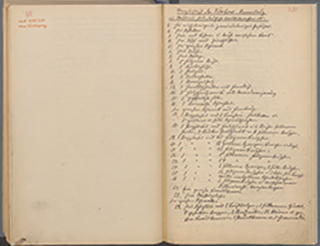Acquisition Logs of the Museum Europäischer Kulturen
Recording period 1876 – 2012
The collection of the MEK (Museum Europäischer Kulturen) is made up of three parts, which were merged in the 1990s: the collection of the East Berlin Museum für Volkskunde, the collection of the West Berlin Museum für Deutsche Volkskunde (1992) and the “European Department” of the Museum für Völkerkunde (1999).
Since its founding in 1889, the collection originally known as the folklore collection had been structured according to “cultural landscapes” – reflective of the cultural-geographical organisation of the Museum für Völkerkunde – and was catalogued accordingly. Once the collection was made into an independent public museum in 1935, the significance of these classificatory parameters dwindled, though they were retained in the ethnological collections. The newly introduced inventory system of the Museum für Deutsche Volkskunde classified primarily according to materials and typologies (known as “subject groups”) and was thus designed to facilitate cultural comparison. This system accorded each object a number within its subject group, as well as an inventory number. Since then, objects have been assigned to subject groups that above all reflect their context of use. The catalogue currently comprises 74 subject groups along with numerous subgroups and can be expanded when needed.
The division of Germany and the parallel existence of ethnological museums in the East and the West resulted in two different systems of cataloguing. The Museum für Volkskunde on the Museumsinsel, where the index cards of the pre-1945 holdings remained, continued to catalogue according to subject groups, although without consecutive object numbers. The Museum für Deutsche Volkskunde in Dahlem inventoried with consecutive object numbers, basing their system – in the absence of the old index cards – on the objects in their collection. Meaning that they restarted their catalogue at the number “1”. For clear identification, the former location was placed in front of each shelf mark with the merger in 1992 – “I” for (Museums-)Insel, “D” for Dahlem, and “A” for Altbestand (old holdings, or the pre-1945 inventory).
Since its foundation in 1935, the “European Department” – previously named the “Eurasian Department” – of the Museum für Völkerkunde divided its holdings according to so-called cultural landscapes or “ethnic groups”. The department was labelled with the Roman numeral “II”. Unlike the Museum für Volkskunde and the Museum für Deutsche Volkskunde, the Museum für Völkerkunde retained this system. As such, the collection continues to be roughly divided into four “cultural landscapes”. Within these holdings, the objects are assigned to ethnic and national groups. Thus, the prefix “A” refers to Northern/Western Europe. The markers II B, II C and II D refer to Eastern and South-Eastern Europe; the original classification was “Slavs, Balkan peoples, Balts and Magyars” (II B), “Turkic peoples and European Finns” (II C) and “the Caucasus” (II D). A separate collection group (II E) comprises the paintings and models of the painter and ethnographer Wilhelm Kiesewetter (1811–1865). In addition, there are the photographic collections of the “European Department”, which are filed under VIII. When the “European Department” was merged with the ethnological collections in 1999, it retained its system, but new objects are not incorporated into it.

